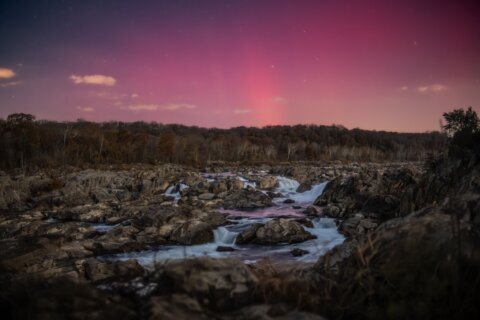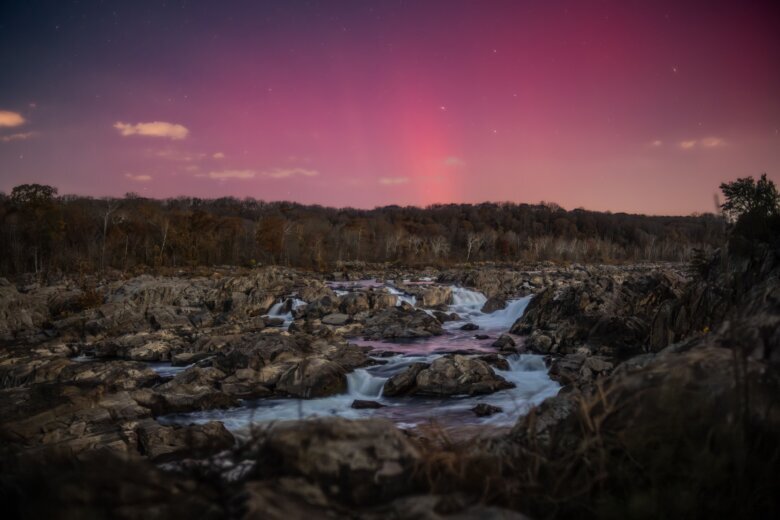Aurora chasers in the D.C. region may have one last, albeit slim, chance to see the northern lights Thursday night. Here’s what to know.

An aurora shines over Great Falls, Maryland, on Wednesday, Nov. 12, 2025. (Courtesy Jared Angle)

An aurora shines over Great Falls, Maryland, on Wednesday, Nov. 12, 2025. (Courtesy Jared Angle)
Wednesday night into the early hours of Thursday morning, patient sky watchers saw greatly diminished aurora off and on in the D.C. area. These sightings were nowhere near the color and brightness observed earlier in the week.
Skies were pretty clear and I imaged weak red pillar aurora, which I never saw with my naked eye, just above the northern horizon around 10 p.m. Similar reports in the D.C. region were made on social media.
Sky watchers, and now full fledged aurora chasers, may have another opportunity Thursday night as the National Oceanic and Atmospheric Administration’s Space Weather Prediction Center issued a “Geomagnetic Storm Category G3 (Strong) Predicted” watch notice Thursday morning.
For the D.C. region, the center’s two-day aurora forecast indicates the best time to look to the north is after it gets dark, at around 7 p.m. Geomagnetic storm levels are forecast to greatly diminish overnight.
 NOAA’s Joint Polar Satellite System satellites captured this dazzling aurora composite imagery of North America from Nov. 11-12. (Courtesy NOAA)
NOAA’s Joint Polar Satellite System satellites captured this dazzling aurora composite imagery of North America from Nov. 11-12. (Courtesy NOAA)
Our best bet is to check for updates throughout the day at Clear Sky Chart (input your location) for sky conditions, NOAA and space-related social media sites, such as spaceweatherlive.com, EarthSky and space.com for aurora viewing updates. There also are aurora apps available to help; I use Aurora Pro and Glendale App.
You might be able to visually detect some color in the sky if bright aurora are present but they will likely be low on the northern horizon.
Your camera and/or smartphone significantly improve your chances of detecting and imaging the aurora due to their digital sensors. Even if you do not see aurora, photograph the northern horizon to possibly get an image of them.
Use a camera or smartphone that can take exposures of several seconds — including using “Night Sky” or “Low Light” settings if your camera has them — of the northern horizon. Steady the camera or use a tripod for best image results. The camera can capture aurora that your eyes did not.
Good luck, aurora chasers, with this forecast we will likely need it …
Follow my daily blog to keep up with the latest news in astronomy and space exploration. You can email me at skyguyinva@gmail.com.
Get breaking news and daily headlines delivered to your email inbox by signing up here.
© 2025 WTOP. All Rights Reserved. This website is not intended for users located within the European Economic Area.
